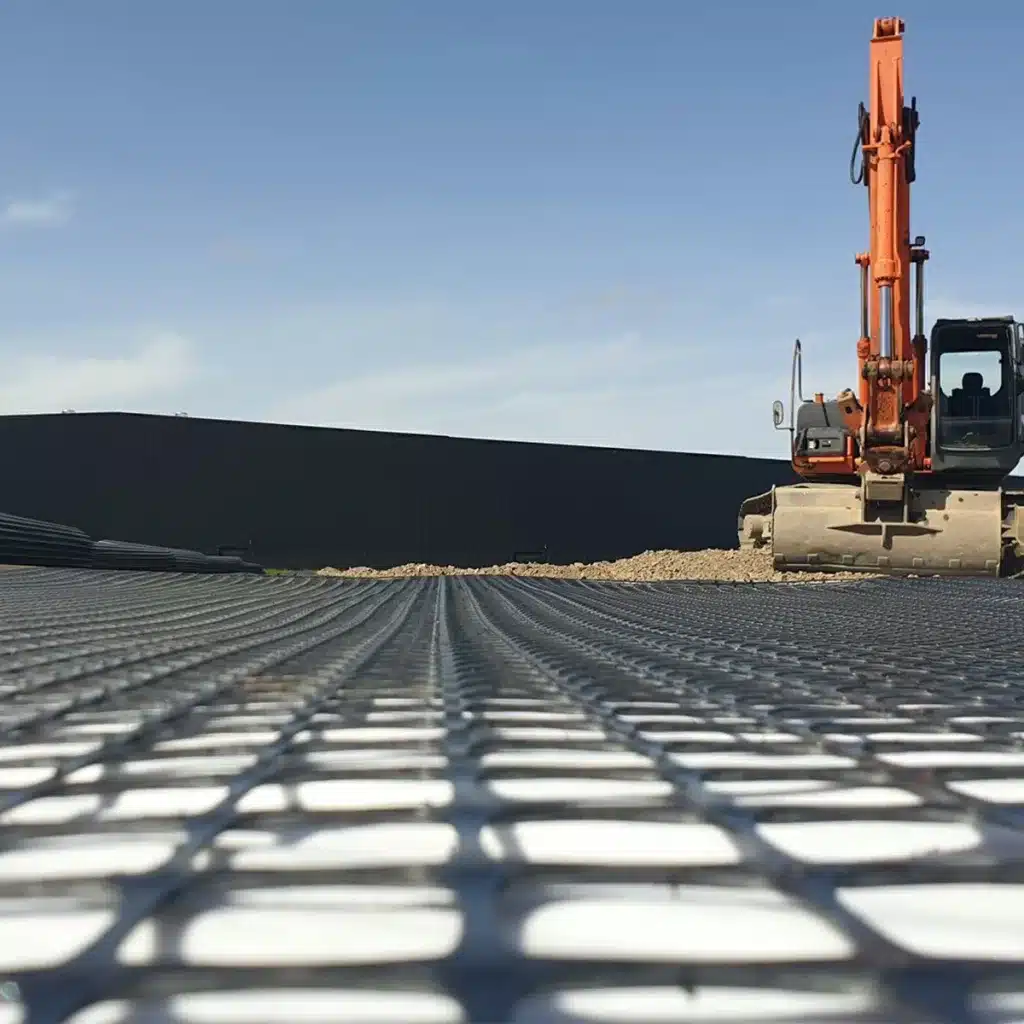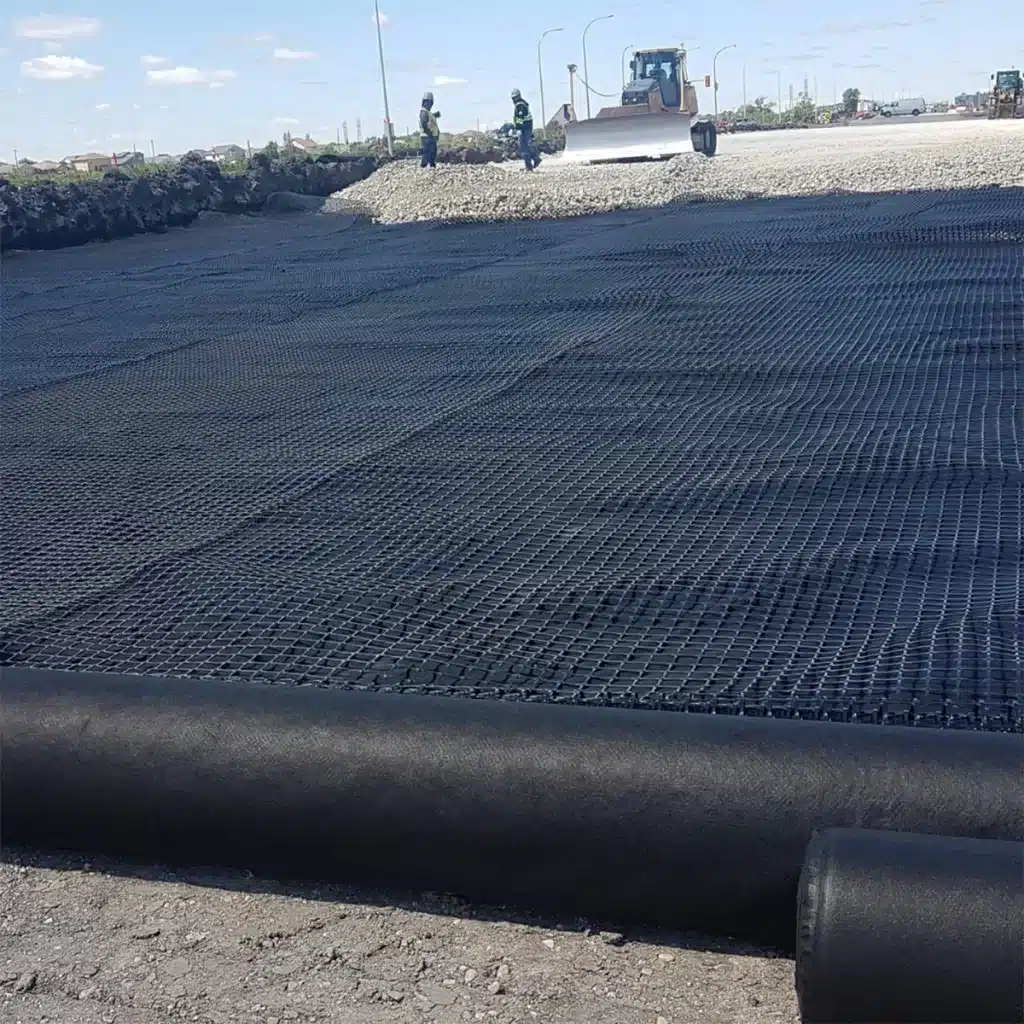+86-159 9860 6917
info@geofantex.com
geofantex@gmail.com
+86-400-8266163-44899
Geogrids are a powerful tool in civil engineering, particularly when it comes to stabilizing slopes and preventing soil erosion. These grid-like structures, made from polymer materials, are widely used in slope reinforcement to improve soil stability and support steep or unstable terrain. In this article, we explore the use of geogrid on slopes, its advantages in reinforcing soil, and how geocells contribute to slope protection. We will also look at how geogrid and related technologies can be used to reinforce steep slopes.
Can you use a geogrid on a slope?
Yes, geogrids can be used on slopes, and they are highly effective in slope stabilization. Here’s how:
Slope Reinforcement: Geogrids help reinforce soil on slopes by providing additional tensile strength, which prevents the soil from sliding or collapsing under pressure. They are often used in reinforced soil structures, like geogrid walls, to increase stability.
Preventing Erosion: Geogrids can be combined with other materials like geotextiles to control erosion on slopes. The geogrid helps hold soil in place, preventing it from washing away due to water runoff.
Applications
- Steep Slopes: In construction and landscaping, geogrids are used to stabilize steep embankments and prevent landslides.
- Retaining Walls: Geogrids are often incorporated in retaining walls to provide additional support to slopes, enhancing their load-bearing capacity.
Benefits
- Increased slope stability
- Enhanced soil strength
- Reduced erosion risk
Using a geogrid on a slope helps create long-lasting, stable soil structures, improving both safety and durability.

What is geogrid reinforced soil slope?
A geogrid reinforced soil slope is a slope that is stabilized and strengthened using geogrids—a type of geosynthetic material. Geogrids are placed within the soil at various layers to provide additional support, improve soil stability, and prevent erosion or landslides. The geogrid’s grid-like structure creates interlocking with the surrounding soil particles, enhancing their load-bearing capacity and resistance to shifting.
Key Features of Geogrid Reinforced Soil Slopes:
- Soil Reinforcement: Geogrids are used to reinforce the soil along the slope. By distributing loads across the soil layers, they prevent deformation and sliding, even on steep slopes.
- Increased Stability: The primary benefit of geogrid reinforcement is the increase in slope stability. Geogrids act as tensile elements that resist tension, helping to hold the soil in place and prevent failure due to gravity, water, or other external forces.
- Erosion Control: Geogrids can reduce soil erosion caused by rainfall or wind. They help hold the soil particles together, reducing the risk of soil displacement.
- Cost-Effective: Compared to traditional methods of slope stabilization (e.g., heavy retaining walls or soil nailing), using geogrids can be more cost-effective and environmentally friendly. They allow for steeper slopes and better use of available space.
Applications:
- Highway Embankments: Geogrid reinforced slopes are commonly used in road construction to stabilize embankments and prevent landslides.
- Landfills: They are also used in landfill construction to stabilize side slopes.
- Retaining Walls: Geogrids are often incorporated into retaining wall systems to enhance the performance of the wall and stabilize slopes.
Benefits:
- Enhanced Structural Integrity: Geogrids strengthen the soil, making the slope more resistant to forces like erosion, gravity, and weathering.
- Improved Drainage: The spacing within the geogrid structure allows water to drain through, reducing hydrostatic pressure buildup and the risk of failure.
- Sustainability: Geogrids are often made from durable, long-lasting materials like polyester or polypropylene, offering a sustainable solution for slope stabilization.
In summary, geogrid reinforced soil slopes provide a reliable, cost-effective solution for stabilizing steep slopes, preventing erosion, and improving overall slope performance in various engineering projects.
What is slope protection with Geocells?
Key Benefits of Using Geocells for Slope Protection:
- Prevents Erosion: Geocells effectively reduce soil erosion by holding the soil in place within the cellular structure. This confinement prevents water runoff from washing away soil, especially during heavy rainfall or flooding.
- Improves Slope Stability: The geocell system increases the shear strength of the soil, providing enhanced slope stability. This is particularly important in areas with steep slopes or unstable terrain that may be prone to landslides or soil shifting.
- Environmental Protection: The use of geocells supports environmental sustainability by reducing the need for hardscaping or chemical erosion control methods. Geocells promote vegetation growth by creating a stable foundation for plants to take root, further enhancing soil stability.
- Cost-Effective: Compared to traditional slope protection methods like retaining walls or concrete structures, geocells offer a more affordable and versatile solution. They are also easier to install, making them a cost-effective choice for large-scale projects.
- Durability: Made from high-quality, weather-resistant materials, geocells are designed to withstand harsh environmental conditions, including extreme temperatures, UV exposure, and heavy traffic.
Applications of Geocells in Slope Protection
- Roads and Highways: Protecting embankments and roadside slopes from erosion due to heavy rainfall and vehicle traffic.
- Construction Sites: Stabilizing slopes during and after construction to prevent soil erosion.
- Landscaping and Parks: Enhancing the aesthetics and stability of sloped areas in parks, gardens, and green spaces.
- Riverbanks and Coastal Areas: Preventing erosion along riverbanks, shorelines, and coastal areas exposed to wave action and tidal forces.
How to reinforce a steep slope?
Reinforcing a steep slope is critical to preventing erosion, improving stability, and avoiding potential landslides or soil movement. Several techniques can be employed, often in combination, to enhance the slope’s integrity. Here are some of the most effective methods:
Geocell Reinforcement
- How it Works: Geocells are three-dimensional, honeycomb-like structures that confine soil, gravel, or other materials within each cell. These systems are placed on steep slopes to stabilize the soil, reduce erosion, and promote vegetation growth.
- Benefits: Erosion control by preventing surface runoff. Improved load distribution, reducing the risk of slippage or soil movement.
- Ideal For: Steep slopes with poor vegetation or areas prone to erosion.
Retaining Walls
- How it Works: A retaining wall is a structure designed to hold back soil on a slope, effectively reducing the risk of erosion or collapse. Retaining walls can be built using various materials such as concrete, stone, or timber.
- Benefits: Provides immediate stabilization for steep slopes. Can be engineered to handle significant weight and stress.
- Ideal For: Extremely steep slopes where other methods might not provide sufficient stabilization.
Terracing
- How it Works: Terracing involves creating a series of stepped levels along a slope. This technique redistributes the slope’s gradient, creating flat or gently sloping platforms that reduce runoff and soil erosion.
- Benefits: Slows down water flow and reduces erosion. Allows for easier management and cultivation of steep land for agriculture or landscaping.
- Ideal For: Agricultural slopes or areas where you need to create usable land on steep gradients.
Soil Nailing
- How it Works: Soil nailing involves inserting steel rods (nails) into the slope at an angle and securing them with grout. The nails stabilize the soil by creating a reinforced matrix that resists movement and increases shear strength.
- Benefits: Provides deep stabilization for steep, unstable slopes. Less intrusive than traditional retaining walls.
- Ideal For: Slopes with loose or highly fractured soil.
Vegetative Reinforcement (Bioengineering)
- How it Works: This method uses plants, shrubs, and trees to reinforce a steep slope. The root systems of the vegetation help bind the soil, while the plants slow down water runoff and absorb moisture, reducing erosion.
- Techniques Include: Hydroseeding: Spraying a mixture of seeds, mulch, and fertilizer onto the slope. Live Stakes or Live Crib Walls: Using live branches or plant material to reinforce the slope.
- Benefits: Eco-friendly and sustainable. Promotes natural slope stabilization over time.
- Ideal For: Slopes with mild to moderate steepness, especially in landscapes where vegetation can thrive.
Riprap
- How it Works: Riprap consists of large stones or rocks that are placed on the surface of a slope or embankment. The rocks create a protective layer that reduces the impact of water runoff and stabilizes the soil underneath.
- Benefits: Provides immediate erosion control, especially in areas with heavy water flow. Long-lasting and resistant to extreme weather conditions.
- Ideal For: Slopes near water sources or areas prone to high rainfall or storm surges.
Incorporating Drainage Systems
- How it Works: Proper drainage is essential for preventing water from accumulating in the soil and causing erosion. Installing French drains, surface drains, or sub-drains can direct water away from the slope, reducing the pressure on the soil and maintaining its stability.
- Benefits: Prevents water buildup, which can weaken the slope and lead to landslides. Enhances the effectiveness of other reinforcement techniques.
- Ideal For: Slopes with significant water runoff or areas with frequent rainfall.
Slope Flattening or Regrading
- How it Works: Regrading involves reshaping the slope to make it less steep. By flattening the angle of the slope, you reduce the gravitational force acting on the soil, making it less prone to sliding or erosion.
- Benefits: Reduces the potential for landslides and soil instability. Creates a safer slope angle that can be more easily stabilized.
- Ideal For: Areas where the slope is dangerously steep and immediate stabilization is required.
Soil Stabilization with Chemical Additives
- How it Works: Chemical additives, such as polymers or lime, can be mixed into the soil to improve its strength, cohesion, and resistance to erosion. These additives bind the soil particles together, making the slope more stable.
- Benefits: Effective for areas with loose or sandy soil. Quick application and immediate effect on soil stability.
- Ideal For: Slopes in areas with poor soil cohesion or sandy soils.
Reinforcing a steep slope requires a combination of techniques tailored to the specific conditions of the site. Geocells, retaining walls, terracing, and vegetative reinforcement are some of the most popular methods for stabilizing steep slopes. Often, a combination of these techniques is the best approach to ensure long-term slope stability and prevent erosion, especially in high-risk areas prone to heavy rainfall, water runoff, or soil instability.
Geogrid technology is a reliable and effective solution for stabilizing and reinforcing slopes, particularly in areas prone to erosion or instability. By using geogrid in combination with other slope protection methods, such as geocells, you can improve the structural integrity of the soil and prevent slope failure. Whether used for gradual slopes or steep inclines, geogrid offers a versatile and sustainable option for slope reinforcement and erosion control.



Get Free Sample
We’ll respond as soon as possible(within 12 hours)





















